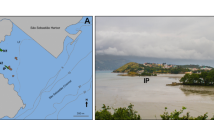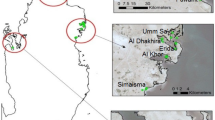Abstract
Structural complexity of mangrove forests is thought to provide critical habitats for a variety of invertebrates. We studied the influence of habitat structure and sampling time on the gastropod diversity in Khuran mangrove ecosystem in the Persian Gulf. Sampling was conducted in two successive years (February and June 2018, February and June 2019) at two mangrove habitats i.e., pneumatophore zone and mudflats. The gastropod assemblages were characterized by the dominance of specific taxa and low species richness. In total, 18 taxa were identified, including 14 species occurring in the mangrove forest and 16 species in the mudflats. Assimineidae dominated the assemblages in both mangrove habitats. Four species (Mitrella blanda, Mitrella cartwrighti, Pellamora densilabrum, Pseudominolia sp.) were found only in mudflat habitats, while two species (Bakawan rotundata, Peronia verruculata) were found only in pneumatophore zones. The gastropod assemblage structure differed significantly between habitats and sampling dates. Of the environmental variables measured, distance-based linear models revealed that total organic carbon (TOC), and total nitrogen (TN) best explained the variation in gastropod assemblage structure. We suggest that conservation efforts should focus not only on preserving mangrove forests, but also upon protecting their adjacent bare mudflats as they provide habitat for various mangrove fauna.




Similar content being viewed by others
References
Adame MF, Reef R, Santini NS, Najera E, Turschwell MP, Hayes MA, Masque P, Lovelock CE (2020) Mangroves in arid regions: Ecology, threats, and opportunities. Estuar Coast Shelf Sci. https://doi.org/10.1016/j.ecss.2020.106796
Agusto LE, Fratini S, Jimenez PJ, Quadros A, Cannicci S (2020) Structural characteristics of crab burrows in Hong Kong mangrove forests and their role in ecosystem engineering. Estuar Coast Shelf Sci. https://doi.org/10.1016/j.ecss.2020.106973
Akbari N, Shojaei MG, Farahani MM, Weigt M (2022) Stable isotopes reveal the food sources of benthic macroinvertebrates in the arid mangrove ecosystem of the Persian Gulf. Estuaries Coasts. https://doi.org/10.1007/s12237-022-01083-9
Alfaro AC (2006) Benthic macro-invertebrate community composition within a mangrove/seagrass estuary in northern New Zealand. Estuar Coast Shelf Sci 66:97–110. https://doi.org/10.1016/j.ecss.2005.07.024
Al-Khayat JA, Abdulla MA, Alatalo JM (2019) Diversity of benthic macrofauna and physical parameters of sediments in natural mangroves and in afforested mangroves three decades after compensatory planting. Aquat Sci 81:1–11. https://doi.org/10.1007/s00027-018-0599-7
Allison, L.E., 1975. Organic carbon In: Black CA. Methods of soil analysis. American Society of Agronomy, Part 2.
Alongi DM (2008) Mangrove forests: resilience, protection from tsunamis, and responses to global climate change. Estuar Coast Shelf Sci 76:1–13. https://doi.org/10.1016/j.ecss.2007.08.024
Anderson, M.J., 2014. Permutational multivariate analysis of variance (PERMANOVA). Wiley statsref Stat Ref online 1–15. https://doi.org/10.1002/9781118445112.stat07841
Ashton EC, Macintosh DJ, Hogarth PJ (2003) A baseline study of the diversity and community ecology of crab and molluscan macrofauna in the Sematan mangrove forest, Sarawak Malaysia. J Trop Ecol. https://doi.org/10.1017/S0266467403003158
Boström C, Törnroos A, Bonsdorff E (2010) Invertebrate dispersal and habitat heterogeneity: Expression of biological traits in a seagrass landscape. J Exp Mar Bio Ecol 390:106–117. https://doi.org/10.1016/j.jembe.2010.05.008
Bouillon S, Connolly RM, Lee SY (2008) Organic matter exchange and cycling in mangrove ecosystems: recent insights from stable isotope studies. J Sea Res 59:44–58. https://doi.org/10.1016/j.seares.2007.05.001
Bremner JM (1960) Determination of nitrogen in soil by the Kjeldahl method. J Agric Sci 55:11–33. https://doi.org/10.1017/S0021859600021572
Chen G-C, Ye Y, Lu C-Y (2007) Changes of macro-benthic faunal community with stand age of rehabilitated Kandelia candel mangrove in Jiulongjiang Estuary China. Ecol Eng 31:215–224. https://doi.org/10.1016/j.ecoleng.2007.07.002
Clarke, K.R., Gorley, R.N., 2006. Primer. Prim. Plymouth.
Degen R, Aune M, Bluhm BA, Cassidy C, Kędra M, Kraan C, Vandepitte L, Włodarska-Kowalczuk M, Zhulay I, Albano PG (2018) Trait-based approaches in rapidly changing ecosystems: a roadmap to the future polar oceans. Ecol Indic 91:722–736. https://doi.org/10.1016/j.ecolind.2018.04.050
Delfan N, Shojaei MG, Naderloo R (2020) Biodiversity and structure of macrozoobenthos communities in the Hara Biosphere Reserve, Persian Gulf Iran. J Anim Environ 12:373–380
Delfan N, Shojaei MG, Naderloo R (2021) Patterns of structural and functional diversity of macrofaunal communities in a subtropical mangrove ecosystem. Estuar Coast Shelf Sci. https://doi.org/10.1016/j.ecss.2021.107288
Dolbeth M, Cardoso P, Grilo T, Raffaelli D, Pardal MÂ (2013) Drivers of estuarine benthic species distribution patterns following a restoration of a seagrass bed: a functional trait analyses. Mar Pollut Bull 72:47–54. https://doi.org/10.1016/j.marpolbul.2013.05.001
Ellis J, Nicholls P, Craggs R, Hofstra D, Hewitt J (2004) Effects of terrigenous sedimentation on mangrove physiology and associated macrobenthic communities. Mar Ecol Prog Ser 270:71–82. https://doi.org/10.3354/meps270071
Ghasemi S, Zakaria M, Mola Hoveizeh N (2011) Abundance of molluscs (gastropods) at mangrove forests of Iran. Am J Sci 7:660–669
Hajializadeh P, Safaie M, Naderloo R, Shojaei MG, Gammal J, Villnäs A, Norkko A (2020) Species composition and functional traits of macrofauna in different mangrove habitats in the Persian Gulf. Front Mar Sci 7:809. https://doi.org/10.3389/fmars.2020.575480
Hemmati MR, Shojaei MG, Taheri Mirghaed A, Farahani MM, Weigt M (2021) Food sources for camptandriid crabs in an arid mangrove ecosystem of the Persian Gulf: a stable isotope approach. Isotopes Environ Health Stud. https://doi.org/10.1080/10256016.2021.1925665
Hewitt JE, Thrush SF, Dayton PD (2008) Habitat variation, species diversity and ecological functioning in a marine system. J Exp Mar Bio Ecol 366:116–122. https://doi.org/10.1016/j.jembe.2008.07.016
Holsman KK, McDonald PS, Armstrong DA (2006) Intertidal migration and habitat use by subadult Dungeness crab Cancer magister in a NE Pacific estuary. Mar Ecol Prog 308:183–195. https://doi.org/10.3354/meps308183
IRIMO (2021) Iranian meteorological office data processing center. Islamic Republic of Iran Meteorological Office, Tehran, Iran
Kamal S, Warnken J, Bakhtiyari M, Lee SY (2017) Sediment distribution in shallow estuaries at fine scale: in situ evidence of the effects of three-dimensional structural complexity of mangrove pneumatophores. Hydrobiologia 803:121–132. https://doi.org/10.1007/s10750-017-3178-3
Kiruba-Sankar R, Krishnan P, Roy SD, Angel JRJ, Goutham-Bharathi MP, Kumar KL, Ragavan P, Kaliyamoorthy M, Muruganandam R, Rajakumari S (2018) Structural complexity and tree species composition of mangrove forests of the Andaman Islands. India J Coast Conserv 22:217–234. https://doi.org/10.1007/s11852-017-0588-3
Koch V, Wolff M (1996) The mangrove snail Thais kiosquiformis Duclos: a case of life history adaptation to an extreme environment. El caracol de manglar Thais kiosquiformis Duclos: un caso de ciclo vital adaptado a ambientes extremos. J Shellfish Res 15:421–432
Kröncke I, Türkay M, Fiege D (2003) Macrofauna communities in the Eastern Mediterranean deep sea. Mar Ecol 24:193–216. https://doi.org/10.1046/j.0173-9565.2003.00825.x
Krone R, Gutow L, Joschko TJ, Schröder A (2013) Epifauna dynamics at an offshore foundation–implications of future wind power farming in the North Sea. Mar Environ Res 85:1–12. https://doi.org/10.1016/j.marenvres.2012.12.004
Lee SY (2008) Mangrove macrobenthos: assemblages, services, and linkages. J Sea Res 59:16–29
Leung JYS (2015) Original research article: Habitat heterogeneity affects ecological functions of macrobenthic communities in a mangrove: Implication for the impact of restoration and afforestation. Glob Ecol Conserv 4:423–433. https://doi.org/10.1016/j.gecco.2015.08.005
Leung JYS, Cheung NKM (2017) Can mangrove plantation enhance the functional diversity of macrobenthic community in polluted mangroves? Mar Pollut Bull 116:454–461. https://doi.org/10.1016/j.marpolbul.2017.01.043
Macintosh DJ, Ashton EC, Havanon S (2002) Mangrove rehabilitation and intertidal biodiversity: a study in the Ranong mangrove ecosystem Thailand. Estuar Coast Shelf Sci 55:331–345. https://doi.org/10.1006/ecss.2001.0896
Macintosh, D.J., Ashton, E.C., 2002. A review of mangrove biodiversity conservation and management. Cent. Trop. Ecosyst. Res. Univ. Aarhus, Denmark
Miller DC, Geider RJ, MacIntyre HL (1996) Microphytobenthos: the ecological role of the “secret garden” of unvegetated, shallow-water marine habitats. II. Role in sediment stability and shallow-water food webs. Estuaries 19:202–212. https://doi.org/10.2307/1352225
Nagelkerken I, Blaber SJM, Bouillon S, Green P, Haywood M, Kirton LG, Meynecke J-O, Pawlik J, Penrose HM, Sasekumar A (2008) The habitat function of mangroves for terrestrial and marine fauna: a review. Aquat Bot 89:155–185. https://doi.org/10.1016/j.aquabot.2007.12.007
Nasi F, Auriemma R, Relitti F, Bazzaro M, Cassin D, Cibic T (2020) Structural and functional response of coastal macrofaunal community to terrigenous input from the Po River (northern Adriatic Sea). Estuar Coast Shelf Sci 235:106548. https://doi.org/10.1016/j.ecss.2019.106548
Nordhaus I, Hadipudjana FA, Janssen R, Pamungkas J (2009) Spatio-temporal variation of macrobenthic communities in the mangrove-fringed Segara Anakan lagoon, Indonesia, affected by anthropogenic activities. Reg Environ Chang 9:291–313. https://doi.org/10.1007/s10113-009-0097-5
Nordhaus I, Salewski T, Jennerjahn TC (2011) Food preferences of mangrove crabs related to leaf nitrogen compounds in the Segara Anakan Lagoon, Java. Indonesia J Sea Res 65:414–426. https://doi.org/10.1016/j.seares.2011.03.006
Nordhaus I, Salewski T, Jennerjahn TC (2017) Interspecific variations in mangrove leaf litter decomposition are related to labile nitrogenous compounds. Estuar Coast Shelf Sci 192:137–148. https://doi.org/10.1016/j.ecss.2017.04.029
Saenger P (2002) Mangrove ecology, silviculture and conservation. Springer Science & Business Media, Dordrecht
Schwamborn R, Ekau W, Voss M, Saint-Paul U (2002) How important are mangroves as a carbon source for decapod crustacean larvae in a tropical estuary? Ma. Ecol Prog Ser 229:195–205. https://doi.org/10.3354/meps229195
Shahraki M, Fry B, Krumme U, Rixen T (2014) Microphytobenthos sustain fish food webs in intertidal arid habitats: a comparison between mangrove-lined and un-vegetated creeks in the Persian Gulf. Estuar Coast Shelf Sci 149:203–212. https://doi.org/10.1016/j.ecss.2014.08.017
Sheppard C, Al-Husiani M, Al-Jamali F, Al-Yamani F, Baldwin R, Bishop J, Benzoni F, Dutrieux E, Dulvy NK, Durvasula SRV (2010) The Gulf: a young sea in decline. Mar Pollut Bull 60:13–38. https://doi.org/10.1016/j.marpolbul.2009.10.017
Sheridan P (1997) Benthos of adjacent mangrove, seagrass and non-vegetated habitats in Rookery Bay, Florida, USA. Estuar Coast Shelf Sci 44:455–469. https://doi.org/10.1006/ecss.1996.0125
Shojaei MG, Farahani MM, Abtahi B, Delfan N, Naderloo R, Kourandeh MB (2022) Sources partitioning in the diet of the mudskipper Periophthalmus waltoni in an arid mangrove system: evidence from stable isotope analysis. Food Webs 31:e00234. https://doi.org/10.1016/j.fooweb.2022.e00234
Shojaei MG, Gutow L, Dannheim J, Rachor E, Schröder A, Brey T (2016) Common trends in German Bight benthic macrofaunal communities: assessing temporal variability and the relative importance of environmental variables. J Sea Res. https://doi.org/10.1016/j.seares.2015.11.002
Soleimanirad A, Kamrani E, Keshavarz M, Bahremand M, Vazirizade A (2014) Comparison of diversity and distribution of polychaetes in the western and eastern Jask protected areas in Jask port (Gulf of Oman). J Oceanogr 4(16):45–53
Taillardat P, Friess DA, Lupascu M (2018) Mangrove blue carbon strategies for climate change mitigation are most effective at the national scale. Biol Lett 14:20180251. https://doi.org/10.1098/rsbl.2018.0251
Thilagavathi B, Varadharajan D, Babu A et al (2013) Distribution and diversity of macrobenthos in different mangrove ecosystems of Tamil Nadu coast, India. J Aquac Res Dev 4(6):199–211
Vahidi F, Fatemi SMR, Danehkar A, Mashinchian Moradi A, Mousavi Nadushan R (2021) Patterns of mollusks (Bivalvia and Gastropoda) distribution in three different zones of Harra Biosphere Reserve, the Persian Gulf Iran. Iran J Fish Sci 20:1336–1353
Vazirizadeh A, Kamalifar R, Safahieh A et al (2011) Macrofauna community structure of Bardestan Mangrove Swamp, Persian Gulf. World J Fish Mar Sci 3:323–331
Wong MC, Dowd M (2015) Patterns in taxonomic and functional diversity of macrobenthic invertebrates across seagrass habitats: a case study in Atlantic Canada. Estuaries Coasts 38:2323–2336. https://doi.org/10.1007/s12237-015-9967-x
Acknowledgements
We are grateful to students without whom the fieldwork would not have been possible, in particular Nastaran Delfan, Melika Farahani, Rahil Nozarpour, Nazanin Akbari and Khatereh Habibi. The authors are grateful to Dr. Reza Naderloo for his constructive comments. This research was supported by the Center for International Scientific Studies and Collaboration, Iran (CISSC-grant number: 484), and Iran National Science Foundation (INSF-grant number: 97000327), both of which are gratefully acknowledged.
Funding
This research was supported by the Center for International Scientific Studies and Collaboration, Iran (CISSC-Grant Number: 484), and Iran National Science Foundation (INSF-Grant Number: 97000327).
Author information
Authors and Affiliations
Contributions
HE and MGS designed the study, collected and analyzed the data. MGS supervised the study. HE, MGS, and JS, wrote a draft of the manuscript. All authors contributed to the revision of the work.
Corresponding author
Ethics declarations
Competing interests
The authors declare that they have no known competing financial interests or personal relationships that could have appeared to influence the work reported in this paper.
Ethical approval
No animal testing was performed during this study.
Additional information
Publisher's Note
Springer Nature remains neutral with regard to jurisdictional claims in published maps and institutional affiliations.
Rights and permissions
Springer Nature or its licensor (e.g. a society or other partner) holds exclusive rights to this article under a publishing agreement with the author(s) or other rightsholder(s); author self-archiving of the accepted manuscript version of this article is solely governed by the terms of such publishing agreement and applicable law.
About this article
Cite this article
Ebadzadeh, H., Shojaei, M.G. & Seyfabadi, J. The effect of habitat structural complexity on gastropods in an arid mangrove wetland. Wetlands Ecol Manage 32, 139–151 (2024). https://doi.org/10.1007/s11273-023-09966-9
Received:
Accepted:
Published:
Issue Date:
DOI: https://doi.org/10.1007/s11273-023-09966-9




